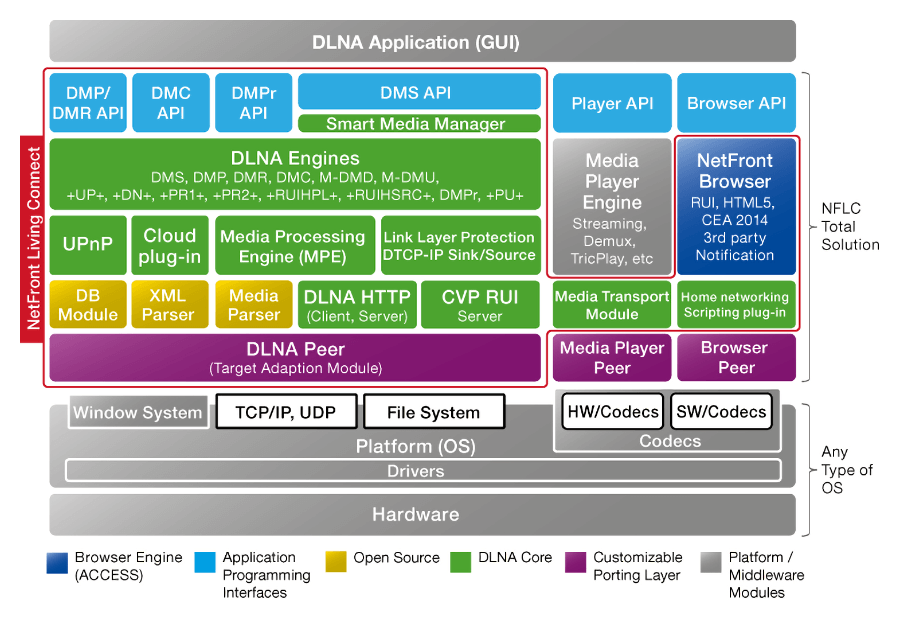- HOME
- Products
- Multiscreen
- Multiscreen Media Sharing for CE Devices and Home Networks
NetFront™ Living Connect is a market-leading technology, based on Digital Living Network Alliance (DLNA) Technology Component™ solution that enables Pay TV operators and device manufacturers to quickly and efficiently implement multi-room and Multiscreen services.* NetFront™ Living Connect can be deployed on set-top boxes, digital TVs, home gateways, smart phones, tablets, digital cameras, network attached storage (NAS) boxes and more.
By applying NetFront™ Living Connect technology an extensive track record of successful DLNA Certified® device deployments has been achieved on a variety of consumer electronic devices offered by leading manufacturers in markets throughout the world. NetFront™ Living Connect is optimized for embedded devices and features high portability as well as flexible modularity, allows easy customization and supports almost any OS or CPU.*
NetFront™ Living Connect provides all the necessary features for enabling robust media sharing devices and services for device manufacturers, content providers and naturally end-users. Furthermore, the combination of ACCESS’ NetFront™ Browser solutions and NetFront™ Living Connect provides link layer protection based on DLNA VidiPath (CVP-2) technology.*
NetFront™ Living Connect was designed from its initial planning stage as an optimal solution for resource-limited embedded environments. This has been proved by porting it to a widely deployed device list, using many different OS and CPU combinations.
NetFront™ Living Connect can be extended by Commercial Video Profile (CVP-2) including HTML5 Remote User Interface and DTCP-IP Content protection. Hence, based on DLNA VidiPath it enables the delivery of television programs and movies to VidiPath certified devices. Service provider can allow consumers to stream their favorite television programs and movies to Consumer Electronic devices such as Smart TV, Tablets, STB and PC's. VidiPath is using HTML5 Remote User Interface technology to provide a consistent user experience across multiple screens. By amending additional CA/DRM technologies and extending it by ACCESS Twine™, secured media distribution across all levels of security to the latest studios' requirements can be realized.*
NetFront™ Living Connect easily integrates with ACCESS' NetFront™ Browser solutions and can be perfectly extended with ACCESS Twine™ Multiscreen technology to leverage the full power of a flexible and portable media solution across multiple devices as well as from homes to cars. Hence, cloud content and social media communities can be easily integrated to the combined feature set of ACCESS' solutions.
Software Development Kit (SDK) for
Supported devices: Set-Top boxes (STB), digital TVs, home gateways, smartphones, tablets, network attached storages (NAS), personal computers, etc.*
Operating Systems: Embedded Linux®, Google® Android®, Apple® iOS™, Microsoft® Windows®, etc.
* ACCESS NetFront™ Living Connect technology is based on DLNA Technology Component™ Solution, ask ACCESS for consulting, integration and customization services on interoperability and certification purposes matching the project’s environment and requirements.
The application footprint is dependent on the target platform and compile options. The figures below can be taken as an example for a Linux build. Figures include SQLite library, EXPAT, ijgjpeg lib, FFMPEG dynamically linked* (DMP, DMR, DMC command-line application without Mediaplayer).
| BINARY | DMS Standard | DMS Media Center* | DMP cmdline | DMR cmdline | DMC | Icon + XML |
|---|---|---|---|---|---|---|
| Executable size | 1.6MB | 2.0MB | 1.2MB | 1.1MB | 1007kB | 60kB |
| Compressed LZMA Flash ROM size | 709kB | 805kB | 508kB | 467kB | 416kB | 46kB |
* Typically the flash requirement for FFMPEG is 2.0 MB. The actual size depends on the compile options. (A 30% variance is possible.)
* Certain codecs require additional license agreements with IP owners (e.g. ac3, divx)
